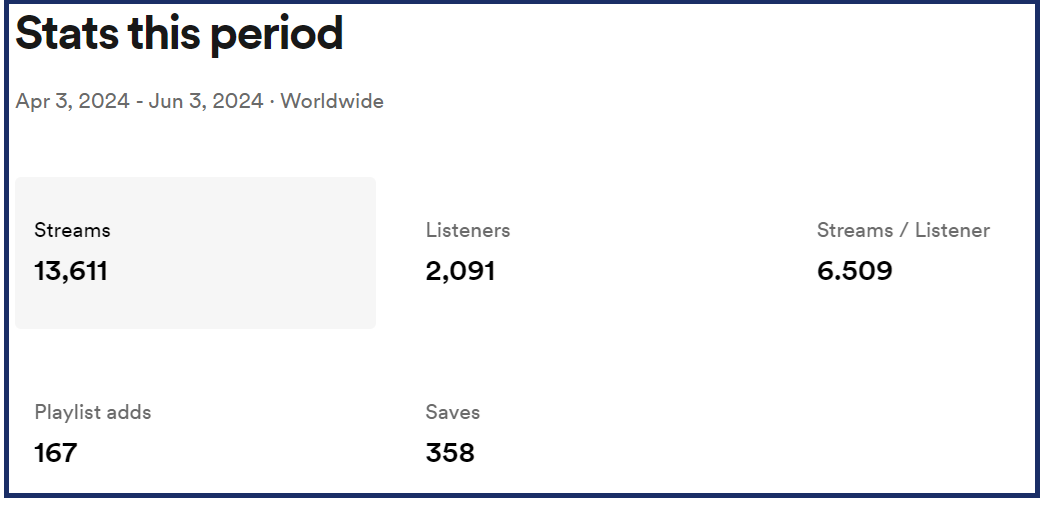I started and run a record label, which means I listen to a lot of music.
I also look at a lot of numbers. I’m talking about streaming and sales analytics. There is SO much data, it’s hard to know what actually matters.
I left investment banking to focus on music. But it seems like I’m right back to where I started: looking at numbers.
Most musicians I know regularly check their Spotify for Artists accounts to see how many streams they’re getting.
But I think it’s important to focus on a few other metrics to get a better and more nuanced gauge of how your music is doing.
I focus on these 5 metrics below.
I’ll use my album Guitar Spring: Music for a New Season as an example (screenshot below). The album didn’t land on any editorial playlists (yet!), and I didn’t buy ads to promote the release.
I made the album with very little intention of promoting it. It’s a good example to use because you can see organic metrics.
1. Skip Rate
While easily overlooked, the skip rate is a treasure trove of immediate listener feedback.
It reveals not just how often a song is skipped before the 30-second mark, but also what it signifies about first impressions.
In a world where attention spans are ever-diminishing, understanding and lowering your skip rate could be the key to retaining listeners and ensuring your tracks play through to the end, increasing your overall streams and, subsequently, revenue.
2. Listener to Follower Ratio
At the intersection of casual listenership and dedicated fandom lies the listener to follower ratio.
This metric sheds light on an artist’s ability to convert casual listeners into committed fans, a critical component for sustainable success on Spotify.
A low ratio calls for strategies to foster deeper connections with your audience, through direct engagement or exclusive content, transforming fleeting listeners into loyal followers.
3. Playlist Additions vs. Listener Increase
Adding a track to playlists is often celebrated as a victory, but the true measure of success is its impact on listener growth.
This metric offers insights into the real value of playlist placements, distinguishing between momentary spikes in popularity and genuine, lasting engagement.
It challenges artists to seek out playlists that do not just increase visibility momentarily but align with their artistic identity and target audience for more meaningful, long-term growth.
4. Save Rate
Beyond streams and follows, the save rate is a critical yet often ignored indicator of listener engagement.
It reflects how many listeners have added your track to their personal library or playlists, a sign of intent to revisit your music.
A high save rate is indicative of deeper listener investment—these are tracks that resonate on a personal level, encouraging repeat listens and fostering a strong artist-listener bond.
I had 358 saves. Or 2.7% of all streams may have resulted in a save. Not amazing. But also not bad.

5. Streams/Listener
This is how many streams every listener played, so it’s a barometer of how deep the engagement is.
I received 6.5 streams per listener, which seems fairly high considering the ~14k total streams. I have few but dedicated fans of my modest guitar music.
Also keep in mind…
The Release Radar algorithmically curated playlist offers a unique opportunity for artists to reach their Spotify followers directly with new releases.
Monitoring your track’s performance on Release Radar can unveil how effectively your music penetrates your existing fan base and attracts new listeners.
The key here lies in understanding the nuances of algorithmic playlisting and leveraging it to maximize your release’s exposure and listener retention.
Success on Spotify is not just about how many people press play, but about how many truly listen, save, and come back for more.
Spotify metrics are a good way to grasp the reach and engagement of your music.
But it isn’t something to obsess over (unless you’re truly trying to monetize aggressively… but that’s another conversation).

0 Comments